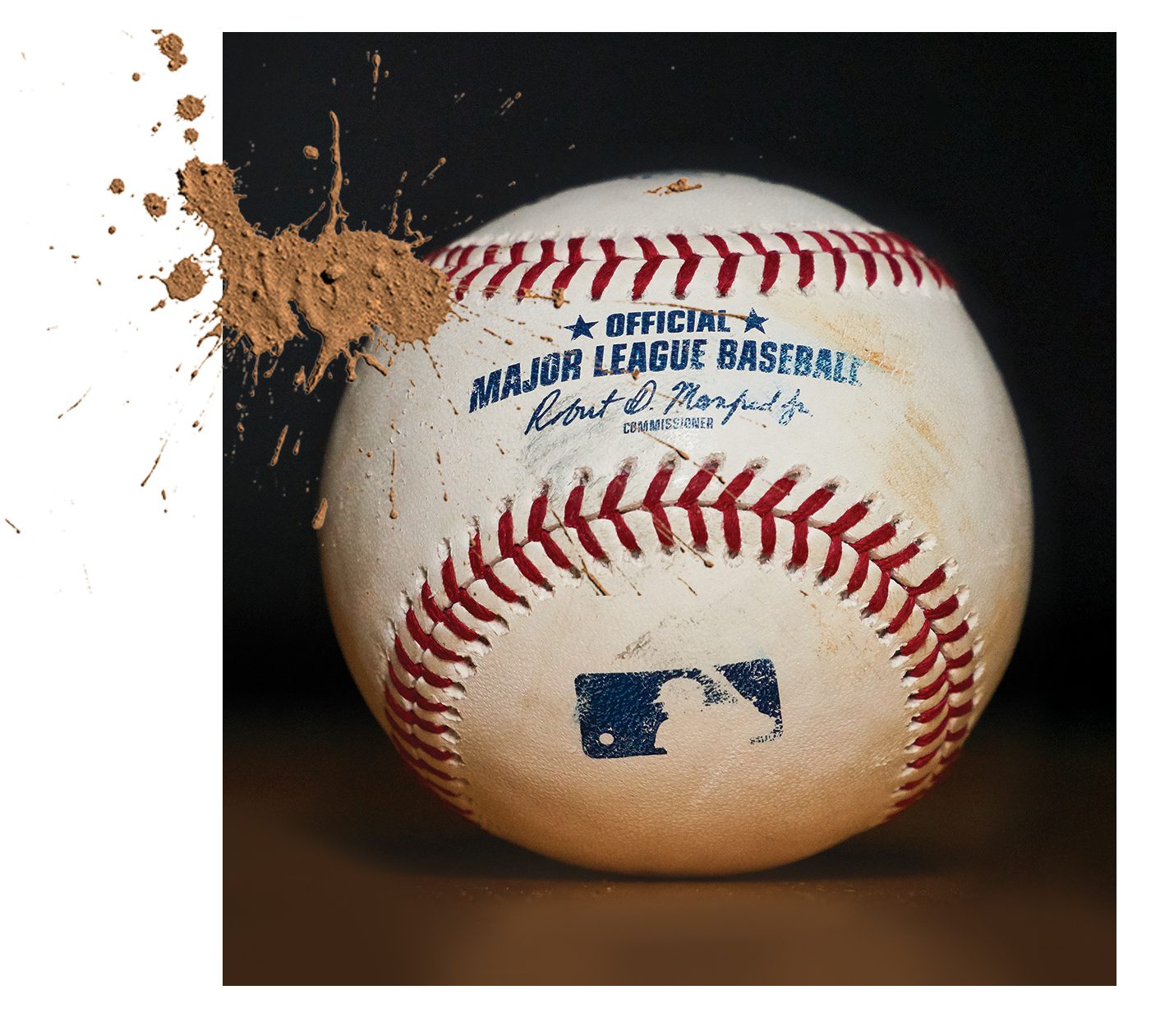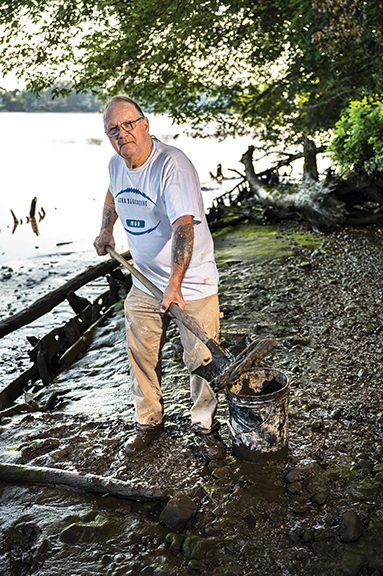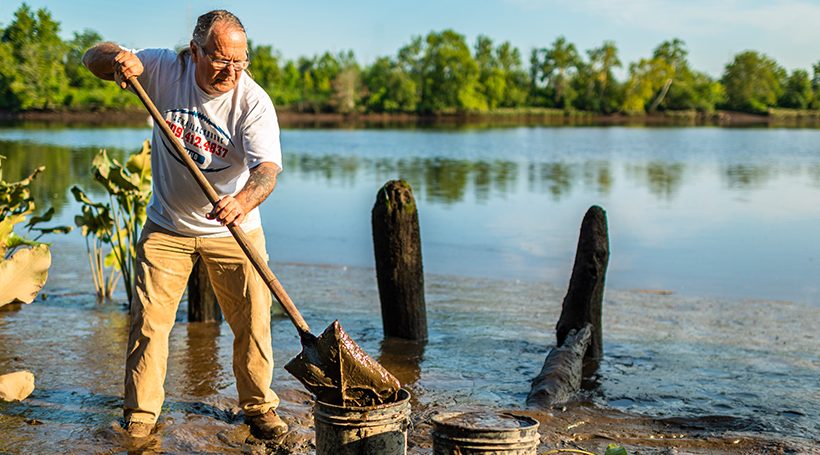Major League Baseball announced this year that teams can only rub one product on their baseballs: a specific kind of mud that comes from a very specific place along the river bank in Burlington County.
And Jim Bintliff is the only guy who knows where.
Photos: David Michael Howarth
This summer, America’s pastime changed. It started in late June, when Major League Baseball cracked down on the use of foreign substances on the ball. For a long time, many – if not most – major league pitchers used some kind of sticky substance to their advantage. A dollop on the back of the glove or the belt is enough to help the pitcher get the grip he wants, but the league feels that creates an unfair advantage. In short, it’s cheating.
In the first month after the crackdown, which involved having umpires inspect pitchers to make sure they weren’t using any sticky stuff, the difference was already noticeable. Sports Illustrated reported that as the spin rate on pitches dropped, walks and hits were on the rise. There were fewer strikeouts, and teams were making more plays on the field.
It’s starting to look like the baseball of a bygone era, and that’s something South Jersey’s Jim Bintliff can appreciate.
“Baseball is a game of tradition. That’s what it’s always been,” the 64-year-old says. “Now there’s this high-tech aspect. They’re counting spin rate! It boggles my mind that they’re getting that technical about it.”
Bintliff’s opinion on the subject is unique, because he’s the man behind the one substance that is allowed on baseballs. In fact, it’s required. And it’s anything but high-tech. From his home in Longport, Bintliff sells buckets and buckets of mud.
Since 1939, major and minor league baseball teams have been using Bintliff’s product, called Lena Blackburne’s Baseball Rubbing Mud, to remove the slippery sheen from the leather of a new baseball. Today, before each game, a dedicated staffer buffs mud into each game ball: the official rulebook says each one should be “properly rubbed so that the gloss is removed.”
This happens to be the only kind of mud that can do the job, and it just so happens to come from a bend on a Delaware River tributary somewhere near Palmyra. Bintliff happens to be the only guy who knows where to find it.
Bintliff’s business dates back more than a century. In 1910, Lena Blackburne, a lifelong Burlington County resident, became the first member of the Palmyra Field Club to play in the Major Leagues. By 1938, he was coaching third base for the Philadelphia Athletics and listening to umpires, pitchers and batters complain about the balls. Players used all kinds of stuff to try to take the gloss off, including tobacco juice, shoe polish and infield dirt, to varying levels of success.
Blackburne remembered the gritty mud of a childhood swimming hole, and the company was born. When it took off, he only trusted one man – Bintliff’s maternal grandfather, John Haas – with the location of the mud patch. When Blackburne died in 1968, Haas inherited the company. Later, it passed to Bintliff’s parents, and he officially took over in 2000.
 All this time, things have gone the same way, year after year. Bintliff goes out to the river with buckets and a shovel, and hauls pounds and pounds of mud back home, where he lets it settle and “age,” then packages it for sale. Teams buy their supply in the spring; usually 4 pro-sized buckets are enough to take them from spring training through the regular season.
All this time, things have gone the same way, year after year. Bintliff goes out to the river with buckets and a shovel, and hauls pounds and pounds of mud back home, where he lets it settle and “age,” then packages it for sale. Teams buy their supply in the spring; usually 4 pro-sized buckets are enough to take them from spring training through the regular season.
This year, with the sticky-stuff ban, Bintliff says there’s more attention on his backyard business than ever. “Now that they’re all of a sudden clamping down, it’s got people looking at my process,” he says. “This season MLB ordered some containers to go to their offices so they could give them to their technicians and try to develop a uniform application process. Everybody does it the way they do it. Some guys use spit, some use water, some don’t use anything.”
It’s not the first time someone’s tried to figure out the secrets of the mud. “My father told me back in the ’70s Rawlings tried to buy him out,” Bintliff says. “It was a million-dollar deal, and he refused it.”
Much more recently, in the 2010s, the major baseball outfitter attempted to recreate the mud, which Bintliff says contains a lot of clay and a lot of feldspar. “It’s in the quartz family, and it’s a super fine grit,” he says. “That’s probably what does most of the work to take the sheen off a baseball without scratching the leather. It’s the geography too. It has to come from a certain bend in the tributary, so it has the right settling properties.”
Bintliff wasn’t threatened by Rawlings. He knows his product is unique. And in the end, he was right.
“I heard they spent a ton of money trying to reproduce it. I pretty much knew it wasn’t going to work,” he says. “Somebody bought some for me, and I got to look at it. It looked and felt like potting soil. I know that was a debacle for them, because they’d produced a bunch of it, and they had such a problem selling it. They started including it for free with a bucket of balls – and all those teams that got some were calling me for mud anyway.”
But that doesn’t mean the mud will always reign supreme. “I see them playing with the covers and the leather more,” Bintliff says. Baseball manufacturers have been testing balls with different surface coatings designed to give the leather more grip. So far, the experiments haven’t really panned out.”
“They tried out those new covers in…I think the Arizona fall leagues,” Bintliff says. “I talked to some of those coaches, and they said they had to use the mud anyway. Pitchers still wanted them rubbed.”
In some ways, the search for a mud replacement may just be an effort to modernize this last, old-fashioned aspect of the game. It could also be about cost-cutting – though in the scope of a major league budget, mud is a pretty minor line item.
“We recently raised the price of a pro bucket,” Bintliff says, “from $75 to $100 a container. But somebody once told me these teams spend more on condiments for the stadium’s boxes. This year, a guy told me they spend more money on laundry detergent, just during spring training, than they do on the mud.”
Still, Bintliff knows eventually there might be a move away from mud, but that, perhaps surprisingly, doesn’t worry him much.
“You know, people ask me if I’m worried about losing the baseball aspect. It would be a hit, but I won’t die,” he says. “If MLB replaces it, sure, I’ll lose a chunk of change. But I can’t control it, and I’m not going to worry about it. I’ll survive.”
 That’s because, in recent years, Bintliff’s been able to diversify. It turns out baseballs aren’t the only sporting projectile that shows up slippery. Brand-new footballs are just as slick, and the mud works on that leather too.
That’s because, in recent years, Bintliff’s been able to diversify. It turns out baseballs aren’t the only sporting projectile that shows up slippery. Brand-new footballs are just as slick, and the mud works on that leather too.
“It’s become so big with football, and they use a lot more of it than baseball teams do,” Bintliff says. “This year’s been ridiculously busy. I’m harvesting and selling considerably more, because about half the teams in the NFL are using it. And since the NFL picked it up, tons of colleges use it for footballs now, too. This has been the busiest summer I’ve ever had.”
It might come as a surprise to Lena Blackburne, John Haas and even Bintliff’s parents to hear that the future of Baseball Rubbing Mud might not necessarily be in baseball. But Bintliff thinks they’d come around to the idea that the future might be in football.
“It’s being used the way it’s always been meant to be used – to better the sport,” he says. Besides, the mud’s legacy in the major leagues is already cemented: there’s a container housed in the Baseball Hall of Fame. “It’s a good feeling to know we’re enshrined there,” Bintliff says. “It’s part of the fabric of the game.”
And for now, Bintliff’s just doing what he’s always done – year after year, season after season – and what he hopes his daughters will continue to do once he eventually passes the business to them.
“It’s comforting,” he says, “that they can’t come up with something better, even in an era when everything else is so mass-produced. You won’t see any products like this around anymore. The only additive here is sweat, and me…I’m just a guy playing in the mud.”














